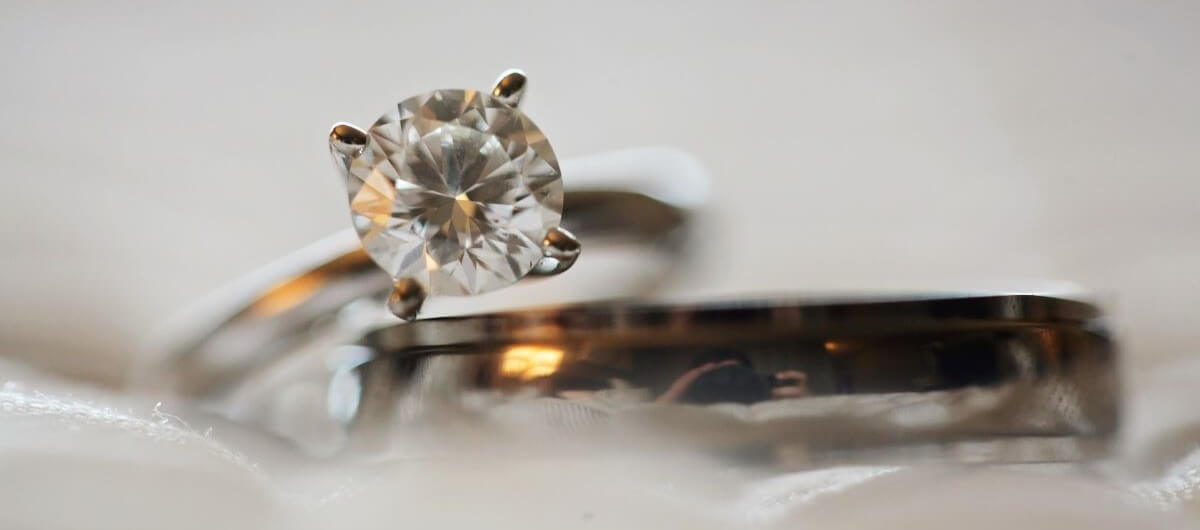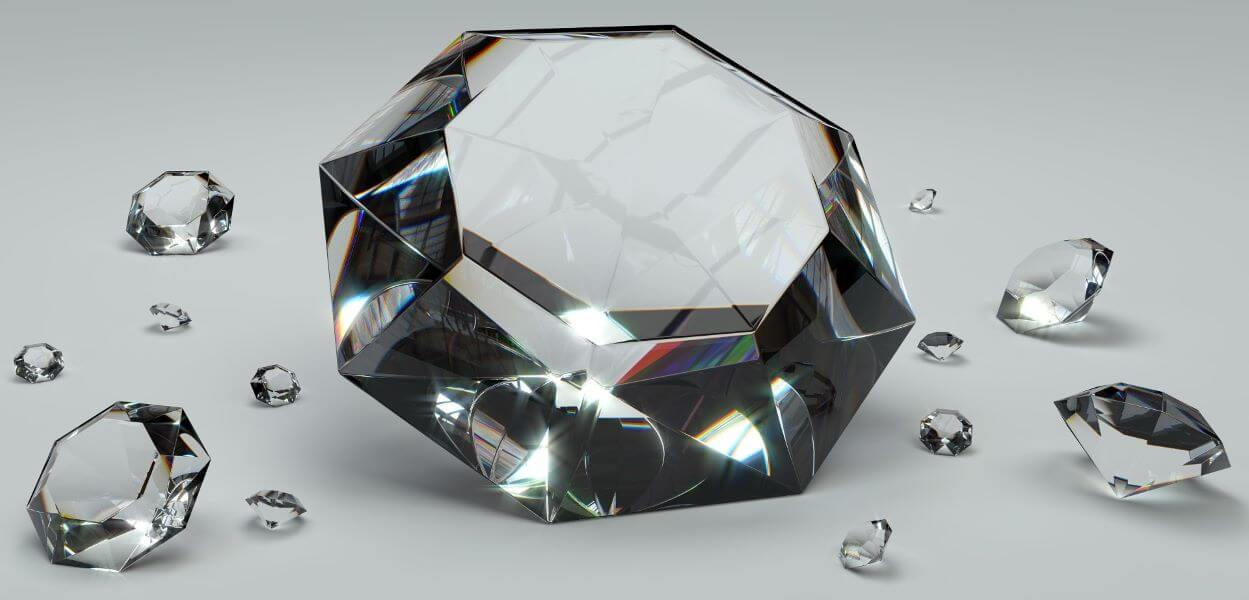Diamond Facts: Americash’s 19 Gems about this Rare Mineral

Diamonds are valuable and beautiful to look at. They’re also fascinating. The precious gem specialists at Americash Jewelry & Coin Buyers don’t just enjoy examining, appraising and dealing in diamonds. We also love talking about them.
Here are some of our favorite fun facts about diamonds. Read on to learn all the interesting diamond facts you’ve ever wanted to know (and more). If you’d like to learn even more directly from our dealers, stop by our location, conveniently located near Downers Grove and Hinsdale.
COMPARE HERE: Carat vs. Karat
1. What is a diamond?
First things first: A diamond is a precious stone that is a solid form of the element carbon, with its atoms arranged in a crystal structure. It has the highest degree of hardness and thermal conductivity of any material occurring in nature. Their toughness and ability to withstand temperatures make diamonds popular in industrial applications, such as cutting and polishing tools. Actually, about 80% of diamonds are used in machine work, rather than in jewelry making.
2. What are diamonds made of?
Unlike other precious stones, diamonds are composed of just one element—pure carbon. Rubies are made of corundum (a mineral composed of aluminum and oxygen molecules). Sapphires also are composed of corundum, with trace amounts of other elements (like iron, titanium, chromium, vanadium, or magnesium). Emeralds are made of beryl, with trace amounts of chromium and/or vanadium giving them their color. A diamond, though, is nothing but carbon.
3. How are diamonds formed?
It takes a lot of time and force to make a diamond. The diamonds used to make the rings, necklaces, and other jewelry we wear were formed more than 3 billion years ago deep within the Earth’s crust. They were created under intense heat and pressure more than 93 miles beneath the surface in the mantle, an area that consists of volcanic magma.
4. What is the etymology of the word “diamond”?
The word “diamond” comes from the Greek word “adamas,” which means indestructible or invincible. It’s a very appropriate name, because a diamond is the hardest substance found on our planet.
5. How hard is a diamond?
To follow up, a diamond features a hardness of 10 on the Mohs scale of mineral hardness, the highest possible score. The softest Mohs scale is 1, the score given to talc.
Interestingly, a diamond is no longer the hardest material found anywhere, thanks to recent scientific discovery. Researchers have learned of the existence of wurtzite boron nitride (approximately 58% stronger than a diamond) in a space-borne meteorite.
6. Are diamonds rare?
Technically, diamonds are not that rare. And no, we’re not fibbing. Scientists estimate that about a quadrillion tons of diamonds lie beneath the Earth’s surface. What’s more, an estimated 147 million carats of diamonds were mined in 2018 alone. So while people sometimes call diamonds “rare” there are a lot of them in circulation, and more are mined every year.
7. What makes diamonds so valuable?
We know diamonds aren’t rare, but why are they so precious and expensive? There are many factors.
For starters, mining diamonds can be a difficult, dangerous process. Turning a raw diamond into the sparkling gem we think of when we think of diamonds is a delicate, painstaking process. To cull one carat of diamond requires miners to sift through up to 250 tons of ore.
Plus, cutting a diamond from a rough stone to an eyecatching, multifaceted gem requires a high degree of skill. Then there’s the cultural meaning and spiritual value we place on these gems. We have come to believe a diamond symbolizes love and commitment. Other qualities people currently and previously associate with diamonds include status, wealth, power, protection and (of course) beauty.
8. What is the history of diamond mining?
Diamonds were first found in India, during the 4th century BC. Many of these stones were transported along the Silk Road, a network of trade routes between that country and China. The stones were valued for their strength and beauty—they were worn as decoration, used as cutting tools, and used as talisman to protect the wearer. India was the world’s primary source of diamonds, and when its mines were depleted, the world began hunting for new sources.
In 1866, a teen found in South Africa what originally appeared to be a plain rock but turned out to be a 21.25-carat diamond. The store of diamonds eventually unearthed after this discovery was so great, the value of diamonds dropped substantially. Today, diamonds can be found in approximately 35 countries, with South Africa, Russia and Botswana being the top producers.
9. Where did the custom of diamond engagement rings first begin?
According to anthropologists, the custom of presenting an engagement ring to propose marriage likely comes from a Roman custom in which a wife wore a ring attached to a small key, indicating that she was her husband’s property. In 1477, Archduke Maximillian of Austria helped kick off the global engagement ring craze by commissioning the first diamond first diamond engagement ring in recorded history for Mary of Burgundy—this gesture caught on among the nobles of Europe and spread for decades. In 1947, the De Beers diamond company launched the slogan, “A Diamond is Forever,” which caused the practice of purchasing diamond engagement rings to skyrocket even further.
10. What are some of the biggest diamonds in history?

- The Cullinan diamond, found in South Africa in 1905, was a whopping 3,106 carats in the rough. It was later cut into 9 large stones and 96 smaller ones—two of them part of England’s famed Crown Jewels.
- The Excelsior, the second-largest diamond found in Africa, is a rough diamond discovered in 1893. It weighs approximately 995.2 carats.
- The Millennium Star diamond (the second-largest colorless, D-rated diamond in the world) was found in the Congo in 1990, and it weighs about 777 carats.
- The Incomparable diamond was found in its rough form in the congo in 1989, weighing approximately 890 carats. After being cut by craftsmen, the yellow-brown diamond weighs 407.48 carats.
- The Sergio black carbonado diamond outweighs the Cullinan in carat weight. Found in Brazil in 1893, this stone weighs a total of 3,167 carats.
More diamond trivia
11. Scientists have discovered a planet that is one-third pure diamond. “55 Cancri e” orbits a star in the Milky Way and was discovered in 2004.
12. Another diamond-studded scientific discovery: Scientists found a star that is essentially a 10-billion-trillion-carat diamond; they named it Lucy (after the Beatles hit “Lucy in the Sky with Diamonds”).
13. Diamonds can also be created in a laboratory under high heat and immense pressure. These diamonds have the same physical, chemical, and optical properties as mined diamonds.
14. The thieves responsible for the notorious Antwerp Diamond Heist of 2003 snuck past 10 layers of security, including infrared detectors, Doppler radar, magnetic field, seismic sensor, and a lock with 100 million possible combinations. Police still aren’t sure how the crooks managed to pull it off.
15. With eight marriages under her belt, actress Elizabeth Taylor collected more than her share of engagement rings. Her third marriage brought the biggest rock—film and theater producer Mike Todd gave her a ring with a 29.4-carat, emerald-cut diamond. She lovingly called it her “ice skating rink.”
16. Pop artist Andy Warhol was fascinated with diamonds. He used a fine layer of diamond dust in a few of his noted paintings, including 1980s works Joseph Beuys and his Diamond Dust Shoes series.
17. In 2007, artist Damian Hirst unveiled For the Love of God, a work consisting of a platinum-cast skull covered in 8,601 diamonds. It cost approximately £14 million ($182.2 million) to make.
18. One of the most famous finished diamonds in the world, the Hope diamond is believed to be cursed, bringing bad luck and tragedy to any who wear or possess it. However, historians believe the curse is a myth created and built upon through the years to increase interest in the stone, and bring up its value.
19. As of January 2020, believed to be the most expensive diamond jewelry ever worn was Lady Gaga’s $30-million, 128.54-carat yellow diamond necklace, sported at the 2019 Oscars. The piece also was worn by Audrey Hepburn during promotions for Breakfast at Tiffany’s.
Want to learn more interesting diamond facts, such as how to sell it for a great price? Contact Americash Jewelry & Coin Buyers. With over 100 years of experience in the trade, we’ll help you out.



